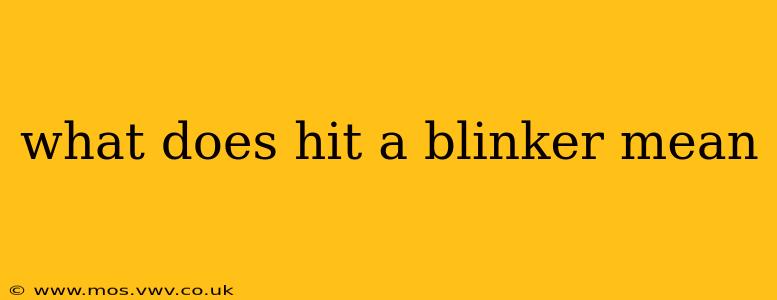What Does "Hit a Blinker" Mean? A Comprehensive Guide to Signaling Your Intentions
The phrase "hit a blinker" is a colloquialism, primarily used in the context of driving. It simply means to activate your turn signal, also known as your blinker, indicator, or flasher. This action signals your intention to change lanes, turn, or make another maneuver on the road.
While seemingly straightforward, understanding the nuances of using your blinker—and the implications of not using it—is crucial for safe and responsible driving. Let's explore some related questions and delve deeper into the importance of this seemingly simple act.
Why is it important to hit your blinker?
Using your turn signal is not just a matter of courtesy; it's a matter of safety. It communicates your intentions to other drivers, pedestrians, and cyclists, allowing them to anticipate your movements and react accordingly. Failing to signal can lead to accidents, near-misses, and dangerous situations. It demonstrates a lack of awareness and consideration for other road users.
What are the legal ramifications of not hitting your blinker?
Laws regarding turn signals vary slightly by location, but generally, failing to signal before changing lanes or turning is a traffic violation. Penalties can range from warnings to fines, and in some cases, points on your driving record. More importantly, ignoring the use of your blinker can lead to more severe consequences in the event of an accident, potentially impacting insurance claims and legal proceedings.
What are some common mistakes people make with their blinkers?
-
Signaling too late: This is perhaps the most common mistake. Signaling just before you begin your maneuver gives other drivers insufficient time to react. Signal well in advance to provide ample warning.
-
Forgetting to turn off your blinker: Many drivers forget to cancel their turn signal after completing a maneuver. This can be confusing to other drivers and indicate a potentially hazardous situation.
-
Using the blinker incorrectly: Using your blinker for actions other than turning or changing lanes is incorrect and confusing. For example, it's not appropriate to use your blinker to express gratitude or warn another driver of a hazard.
-
Not signaling when merging: Merging onto a highway or busy road requires a clear signal to indicate your intention to join the flow of traffic.
What is the difference between a blinker and a hazard light?
While both involve flashing lights, they serve different purposes. A blinker signals an intended change in direction, while hazard lights, also known as emergency flashers, indicate an emergency situation, such as a breakdown or a need for immediate assistance. Hazard lights should never be used to signal a lane change.
What should I do if my blinker isn't working?
If your blinker malfunctions, it's crucial to get it repaired as soon as possible. Driving without a functioning blinker is dangerous and illegal. In the meantime, you may need to rely on hand signals to indicate your intentions, but this should be considered a temporary solution until your blinker is repaired. Consult your vehicle's owner's manual or a qualified mechanic for assistance.
In conclusion, "hitting your blinker" is a seemingly simple act with significant safety and legal implications. By consistently and correctly using your turn signals, you contribute to a safer and more predictable driving environment for everyone. Remember, signaling your intentions is a fundamental aspect of responsible and courteous driving.
